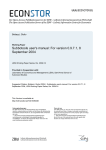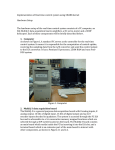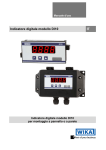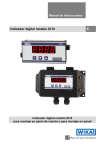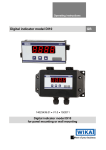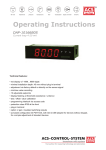Download Calctab user manual
Transcript
calctab package
version 0.6.1
Roberto Giacomelli
e-mail: giaconet dot mailbox at gmail dot com
2009/07/12
“The table computes the sum
not because is useful,
but because the result
is not an user essential data”
Contents
1 Introduction
2
2 User manual
2.1 calctab and xcalctab by examples . . . . . . . . . .
2.1.1 A simple table . . . . . . . . . . . . . . . .
2.1.2 Quantity and price columns . . . . . . . . .
2.1.3 Items relations . . . . . . . . . . . . . . . .
2.1.4 Subtotals . . . . . . . . . . . . . . . . . . .
2.1.5 An arithmetic argument . . . . . . . . . . .
2.1.6 Sum of sums . . . . . . . . . . . . . . . . .
2.1.7 Interval selection . . . . . . . . . . . . . . .
2.2 Environments formal syntax . . . . . . . . . . . . .
2.2.1 calctab syntax . . . . . . . . . . . . . . . . .
2.2.2 xcalctab syntax . . . . . . . . . . . . . . . .
2.3 The table appearance commands (at the moment)
2.4 Incrementing the table width . . . . . . . . . . . .
2.5 New command with calctab environments . . . .
2.5.1 One command, one table . . . . . . . . . .
2.5.2 Inner table command . . . . . . . . . . . .
.
.
.
.
.
.
.
.
.
.
.
.
.
.
.
.
.
.
.
.
.
.
.
.
.
.
.
.
.
.
.
.
.
.
.
.
.
.
.
.
.
.
.
.
.
.
.
.
.
.
.
.
.
.
.
.
.
.
.
.
.
.
.
.
2
. 2
. 2
. 3
. 4
. 4
. 5
. 6
. 6
. 7
. 7
. 8
. 9
. 9
. 9
. 9
. 10
3 calctab idea
10
4 ToDo
11
5 Package License
11
6 Thanks and acknowledgments
11
7 Change history
12
1
2
1
USER MANUAL
Introduction
The calctab package helps the user to typeset a kind of economic table such as invoices,
expence notes and liquidation, or other tabular material with numeric columns.
A standard tabular environment works well but forces the author to think in a generic
LATEX language to reference economic object and without a conceptual relation among
them. In addition a lot of formatting commands takes the same relevance of the main
data, values, text description, etc.
Economic items maybe are independent values or not, like sums and percentages
on previous values. The language must be expressive concerning together data and its
relations. So, the priority is to add a new language element.
2
User manual
This section will be explain the use of the two calctab environments calctab and
xcalctab, first through several examples and then showing its formal syntax.
2.1
2.1.1
calctab and xcalctab by examples
A simple table
Well, starting with a simple case of a list of three entries, a 10% tax apply on it, and
the final sum as showed in the next table:
e
Items description
A
B
C
D
First cost
Second cost
Third cost
Tax (10,00% on A+B+C)
12 500,90
8 560,03
9 200,45
3 026,14
Total cost (A+B+C+D)
33 287,52
The user can typesetting the example table with the followed calctab code (obviously, the directive \usepackage{calctab} must be present in the document preamble).
% in the document preamble
\usepackage{calctab}
1
2
3
4
5
6
7
8
% in the document body
\begin{calctab}
\amount{First cost}{12500,9}
\amount{Second cost}{8560,03}
\amount{Third cost}{9200,45}
\perc{Tax}{10}
\add{Total cost}
\end{calctab}
Probably, is better to show the sum on which the 10% tax is applied. Look this code:
1
2
3
4
5
6
7
8
\begin{calctab}
\amount{First cost}{12500,9}
\amount{Second cost}{8560,03}
\amount{Third cost}{9200,45}
\add{Partial total}
% <-- The ’Partial total’ row is not
\perc{Tax}{10}
%
considered in the ’Total cost’ sum...
\add{Total cost}
\end{calctab}
2
2.1 calctab and xcalctab by examples
2
USER MANUAL
Since the \add command not adds new table element in the stack so is easy to insert
a subtotal. This is one of the basic rules implicit in the calctab environment so you are
free to add an \add row without you worry about following row’s computation. In other
words, the \add command is a trasparent math object.
The behaviour of the inner commands is based on these main rules:
• Each command typeset one table row;
• The sequence of commands produce the sequence of the table rows;
• The \perc and the \add commands computes all previous values (with exception
to the \add rows);
• Optional command argument provides a relation rows language to select an item
or a group of items.
An independent item is not only a numeric data but also it’s defined by a description
text. This concept is directly express by the \amount command which needs two
mandatory arguments: the description text and the item numeric consistency.
No more different is a percentage object structured in a description text and in a
numeric value this time not an absolute number but a factor multiply by one hundred
applied on some previous data, still we can easy express this with the \perc command.
Finally, we encountered a sum that only needs a description text. The calctab
language provides the \add command to cover this concept.
These three commands are available in an environment called calctab that represents
the comprehensive structure of a table.
The code implementation of the inner commands computes the numeric results with
the floating point algorithm rounded it with a max of two decimal digit (currently the
results are truncated at this fixed precision). The number of the commands mandatory
argument can be negative.
The calctab environments manages all the table format elements such as the rows
color, the rules, the columns header description text, etc. Furthermore, the code executes
the data numeric formatting, the font family selection and more. For example, to the
rows description text the \add and \perc commands adds a list of uppercase alphabetical
character to explicate the computed rows.
Potentially all of these visual property could be adjust by the calctab user.
2.1.2
Quantity and price columns
The calctab package provides another environment called xcalctab where the x character
suggests a multiply operation and an extension of the base calctab too. The inner
commands are the same already discussed except the \amount command that accepts
the description test and two numbers indeed only one.
The final table will appears with three columns typesetting with the two numeric
arguments and their product. The following table with its corresponding code clarify
this structure:
Items description
A
B
C
D
E
F
G
Newspapers
Coloured pencils
Maths exercise book
Compass
Ruler
Protractor
Deduction (−5,00% on A+B+ ⋅ ⋅ ⋅ +F)
Total (A+B+ ⋅ ⋅ ⋅ +G)
Q.ty
Price
e
3,00
12,00
6,00
1,00
1,00
1,00
1,30
6,00
2,50
9,90
5,90
6,80
3,90
72,00
15,00
9,90
5,90
6,80
−5,68
107,82
3
2.1 calctab and xcalctab by examples
1
2
3
4
5
6
7
8
9
10
2
USER MANUAL
\begin{xcalctab}
\amount{Newspapers}{3}{1,30}
\amount{Coloured pencils}{12}{6,00}
\amount{Maths exercise book}{6}{2,50}
\amount{Compass}{1}{9,90}
\amount{Ruler}{1}{5,90}
\amount{Protractor}{1}{6,80}
\perc{Deduction}{-5}
\add{Total}
\end{xcalctab}
The help text A+B+C+D+⋅ ⋅ ⋅+⟨LAST ⟩, will be shorted when the items are more
than five elements, in A+B+⋅ ⋅ ⋅+⟨LAST ⟩. The abbreviation condition is true only if
the items in the subgroup are a consecutive sequence.
2.1.3
Items relations
If more complex tables require relational information between rows is necessary to assign
an items names and to recall later these identifiers in a list. This simply way can be
achieved with the command optional argument.
A name can be assign to a table row by using the id key (a significance name of the
key improve code clarity). The syntax is based to ⟨key⟩ = ⟨value⟩ assignment, where
key is the fixed id string. Later on, compute sum or percentage only on a subset of
previous calctab items, can get recall in a comma separated list, the user row names.
The next example explains the language support to the rows relation by naming
with commands optional argument at work. For example, we want to apply a different
discount on each expense or on each group of expense.
e
Items description
A
B
C
D
1
2
3
4
5
6
7
Five dinner
Five breakfast
Discount (−8,00% on A)
Discount (−4,00% on B)
146,00
35,00
−11,68
−1,40
Grand total (A+B+C+D)
167,92
\begin{calctab}
\amount[id=dinner]
{Five dinner}{146}
\amount[id=breakfast]{Five breakfast}{35}
\perc[dinner]
{Discount}{-8}
\perc[breakfast]{Discount}{-4}
\add{Grand total}
\end{calctab}
2.1.4
Subtotals
To the table of the last example we will add a subtotal as the sum of the discount rows.
These \perc rows handling together own identifiers and a list of previous names (one id
name list in this case). As the reader can be notice, the optional table description is
typeset as a paragraph having the same (variable) table width.
4
2.1 calctab and xcalctab by examples
2
USER MANUAL
Hotel bill:
Period from 12 october 2008 to 18 october 2008
(room 456)
e
Items description
A
B
C
D
1
2
3
4
5
6
7
8
9
Five dinner (29,20 × 5,00)
Five breakfast (7,00 × 5,00)
Discount (−8,00% on A)
Discount (−4,00% on B)
146,00
35,00
−11,68
−1,40
Total of discount (C+D)
−13,08
Grand total (A+B+C+D)
167,92
\begin{calctab}[Hotel bill:\\
Period from 12 october 2008 to 18 october 2008 (room 456)]
\amount[id=dinner]
{Five dinner} {29,2 * 5}
\amount[id=breakfast]
{Five breakfast}{ 7 * 5}
\perc[id=dis8,dinner]
{Discount}
{
-8}
\perc[id=dis4,breakfast]{Discount}
{
-4}
\add[dis8,dis4]
{Total of discount}
\add
{Grand total}
\end{calctab}
2.1.5
An arithmetic argument
The last example silently uses a feature of the \amount command (only for calctab and
not for xcalctab) available from the version 0.6. The numeric argument can optionally
be a binary math expression. The parse algorithm is very simple and the only syntax
allowed are show in Tab. 1 where ⟨a⟩ and ⟨b⟩ are two decimal numbers.
Table 1: calctab \amount command optional binary operation
Floating point operation
Addition
Addition
Subtraction
Subtraction
Multiplication
Multiplication
Division
Division
Symbolic description
Numeric example
⟨a⟩ + ⟨b⟩
−⟨a⟩ + ⟨b⟩
⟨a⟩ − ⟨b⟩
−⟨a⟩ − ⟨b⟩
⟨a⟩ ⋅ ⟨b⟩
−⟨a⟩ ⋅ −⟨b⟩
⟨a⟩ / ⟨b⟩
−⟨a⟩ / ⟨b⟩
15,20 + 41
−15,20 + 41
15,20 − 41
−15,20 − 41
15,20 ∗ 41
−15,20 ∗ −41
15,20/41
−15,20/41
Sometimes the applied round off number must be show in the table. This is possible
because calctab reports the \amount binary operations. Here is an example.
e
Items description
A
B
A rounded cost (4 506,00 − 6,00)
Positive rounded cost (3 598,30 + 1,70)
Total (rounded) (A+B)
1
2
3
4
5
\begin{calctab}
\amount{A rounded cost}{4506-6}
\amount{Positive rounded cost}{3598,30+1,70}
\add{Total (rounded)}
\end{calctab}
5
4 500,00
3 600,00
8 100,00
2.1 calctab and xcalctab by examples
2.1.6
2
USER MANUAL
Sum of sums
The next table a 20% deduction amount must be apply on the total of the first three
values (see the F row). A solution is to assign a name for each rows and to write its list
in the optional argument of \perc command. Nevertheless, this sum is just computed
in previus row, thus we can assign a name only to row \add[id=total]{Total amount
of the design task}, and later recall the result and then apply percentage on it with
the line \perc[total]{Deduction}{-20}.
Plant project Fee Note:
Italian restaurant and pizzeria “La Margherita”
e
Items description
A
B
C
D
E
F
Design of the air conditioned plant
Design of the electric plant and video surveillance
General expence (8,55% on A+B)
5 400,00
8 000,00
1 145,70
Total amount of the design task (A+B+C)
14 545,70
Tax (2,00% on A+B+C)
VAT (20,00% on A+B+C+D)
Deduction (−20,00% on A+B+C)
290,91
2 967,32
−2 909,14
Total (A+B+ ⋅ ⋅ ⋅ +F)
14 894,79
The complete code is showed here:
1
2
3
4
5
6
7
8
9
10
11
\begin{calctab}[Plant project Fee Note:\\
Italian restaurant and pizzeria ‘‘La Margherita’’]
\amount{Design of the air conditioned plant}{5400}
\amount{Design of the electric plant and video surveillance}{8000}
\perc{General expence}{8,55}
\add[id=total]{Total amount of design task}
\perc{Tax}{2}
\perc{VAT}{20}
\perc[total]{Deduction}{-20}
\add{Total}
\end{calctab}
2.1.7
Interval selection
The interval selection of a elements list is simply an identification of consecutive elements.
So we only need to specify the first and the last elements delimiters of the series. If the
first delimeter is not an explicit information, we can give to the first list element this
role. Equally, the default last element of the interval can be the last list element, if one
is not available.
The calctab commands \perc and \add supports the interval selection with from
and until keys that referenced row name. For example in this follow table the first five
items and the last four are two separated groups.
Is possible to combine the key until with the key from in the same optional argument
to select a completely defined inner interval. In case of a selection overlap, a package
warning will be throw at compile time.
6
2.2
Environments formal syntax
2
USER MANUAL
The interval selection table
e
Items description
A
B
C
D
E
One
Two
Three
Four
Five
100 000 000,00
20 000 000,00
3 000 000,00
400 000,00
50 000,00
F
G
H
I
Six
Seven
Eight
Nine
6 000,00
700,00
80,00
9,00
From one to five (A+B+C+D+E)
123 450 000,00
From six to nine (F+G+H+I)
6 789,00
From five to six (E+F)
56 000,00
As well as total (A+B+ ⋅ ⋅ ⋅ +I)
1
2
3
4
5
6
7
8
9
10
11
12
13
14
15
16
123 456 789,00
\begin{calctab}[The interval selection table]
\amount
{One}{100000000}
\amount
{Two}{20000000}
\amount
{Three}{3000000}
\amount
{Four}{400000}
\amount[id=five]{Five}{50000}
\inrule
\amount[id=six] {Six}{6000}
\amount
{Seven}{700}
\amount
{Eight}{80}
\amount
{Nine}{9}
\add[until=five]{From one to five}
\add[from=six]{From six to nine}
\add[from=five,until=six]{From five to six} % same of [five,six]
\add{As well as total}
\end{calctab}
An inner rule is adding manually to the table with command \inrule (that just
sounds inner rule).
2.2
Environments formal syntax
2.2.1
calctab syntax
The calctab environment syntax will be described in succession:
\begin{calctab}[⟨description paragraph⟩]
⟨calctab commands list⟩
\end{calctab}
The ⟨calctab commands list⟩ is a sequence of the internal commands \amount, \perc,
\add and \inrule.
\amount[⟨key-value identifier ⟩]{⟨description⟩}{⟨value⟩}
⟨key-value identifier ⟩ = id=⟨rowID⟩;
⟨description⟩ = ⟨text line⟩;
⟨value⟩ = ⟨decimal value⟩ or ⟨basic binary operation⟩.
7
2.2
Environments formal syntax
2
USER MANUAL
\perc[⟨key-value list⟩]{⟨description⟩}{⟨percentage⟩}
⟨key-value list⟩ = id=⟨rowID⟩, from=⟨rowID⟩, until=⟨rowID⟩, ⟨rowID list⟩;
⟨description⟩ = ⟨text line⟩;
⟨value⟩ = ⟨percentage decimal value⟩.
\add[⟨key-value list⟩]{⟨description⟩}
⟨key-value list⟩ = id=⟨rowID⟩, from=⟨rowID⟩, until=⟨rowID⟩, ⟨rowID list⟩;
⟨description⟩ = ⟨text line⟩.
\inrule
2.2.2
xcalctab syntax
The xcalctab environment syntax will be described in the next paragraph:
\begin{xcalctab}[⟨description paragraph⟩]
⟨xcalctab commands list⟩
\end{xcalctab}
The ⟨xcalctab commands list⟩ is a sequence of the internal commands \amount, \perc,
\add and \inrule.
\amount[⟨key-value identifier ⟩]{⟨description⟩}{⟨value1 ⟩}{⟨value2 ⟩}
⟨key-value identifier ⟩ = id=⟨rowID⟩;
⟨description⟩ = ⟨text line⟩;
⟨value1 ⟩ = ⟨decimal value⟩;
⟨value2 ⟩ = ⟨decimal value⟩.
\perc[⟨key-value list⟩]{⟨description⟩}{⟨percentage⟩}
⟨key-value list⟩ = id=⟨rowID⟩, from=⟨rowID⟩, until=⟨rowID⟩, ⟨rowID list⟩;
⟨description⟩ = ⟨text line⟩;
⟨value⟩ = ⟨percentage decimal value⟩.
\add[⟨key-value list⟩]{⟨description⟩}
⟨key-value list⟩ = id=⟨rowID⟩, from=⟨rowID⟩, until=⟨rowID⟩, ⟨rowID list⟩;
⟨description⟩ = ⟨text line⟩.
\inrule
Please note that the calctab and xcalctab environments are based on the standard
LATEX tabular environment, so you can manage your table as a float object all-surrounding
it with a table environment.
8
2.3
The table appearance commands (at the moment)
2.3
2 USER MANUAL
The table appearance commands (at the moment)
The first row of the table typeset by calctab environment contains a pair of texts.
The title of description column, that can be modify by the user with the command
\ctdescription, and the title of economic column that describe currency, set by the
command \ctcurrency. Default values are “Items description” and \euro.
These command save the argument in defined internal macro, in the same way of
the common \title and \author command of the article class. Insert these commands
before the calctab environment to change it.
\ctcurrency{⟨user text⟩}
\ctdescription{⟨user text⟩}
A table example show explicit assignment of the description text and currency unit
after this commands:
1
2
\ctdescription{Your bill, thanks a lot.}
\ctcurrency{USD}
Your bill, thanks a lot.
A
B
C
D
USD
Five dinner
Five breakfast
Discount (−8,00% on A)
Discount (−4,00% on B)
146,00
35,00
−11,68
−1,40
Grand total (A+B+C+D)
167,92
The default english text in percentage row can be changed in the same way with the
command \ctontranslation.
\ctontranslation{⟨on traslation⟩}
and the headers of the two xcalctab numeric columns can be setting with
\ctheaderone{⟨first text header ⟩}
2.4
\ctheadertwo{⟨second text header ⟩}
Incrementing the table width
The width of the calctab table can be adjust via a standard LATEX length called \ctsep
(default value is 8mm). The horizontal space will be add to the central column of the
table. The next line is an example:
\setlength{\ctsep}{28pt}
2.5
New command with calctab environments
Some cases requires repetitive tasks with tables. How calctab can help to do these?
2.5.1
One command, one table
A table similar to calctab basic structure can to be build with a unique command.
1
2
3
4
5
6
\newcommand{\billtab}[2][10]{% two arg command
\begin{calctab}[This is my table]
\amount{Confirmed cost}{#2}
\perc{Tax}{#1}
\add{Total}
\end{calctab}}
9
3
CALCTAB IDEA
When you write: \billtab{2800} you achieved this table:
This is my table
e
Description
A
B
Confirmed cost
Tax (10,00% on A)
Total (A+B)
2 800,00
280,00
3 080,00
and with the command \billtab[20]{2000} you achieved:
This is my table
e
Description
A
B
Confirmed cost
Tax (20,00% on A)
Total (A+B)
2.5.2
2 000,00
400,00
2 400,00
Inner table command
Sometimes is useful to insert only one command to insert several rows of calctab
computation. The next code is an example.
1
2
3
4
5
\newcommand{\closetable}[1][10]{
\add{Subtotal}
\perc{Tax}{#1}
\add{Total}
}
With this command the user can write shortly:
1
2
3
4
5
\begin{calctab}
\amount{Cost}{1200}
\amount{Save pricing}{-400}
\closetable
\end{calctab}
e
Description
A
B
Cost
Save pricing
1 200,00
−400,00
Subtotal (A+B)
C
Tax (10,00% on A+B)
Total (A+B+C)
3
800,00
80,00
880,00
calctab idea
The language efficacy is particularly important for the LATEX user. The calctab
underline concept is to build an expressive language for the model – view paradigm.
So one model of structured data, can have more and more presentation view. For
example, a text with tabular structure can became a report or a graphic plot image.
10
6
4
THANKS AND ACKNOWLEDGMENTS
ToDo
A big work remain to do until the release 1.0 version: a language design and implementation too of a new user interface that make easy modify the view paramenter of the table
such as the type of label row (number, letter and so on), or to define the description
text in the header column.
This list report tasks:
• write in good english the package documentation;
• internationalization of the fixed text in table and the currency unit;
• data input and inner commands language development;
• new infrastructure to manage the table view properties;
• ...
5
Package License
This work may be distributed and/or modified under the conditions of the LATEX Project
Public License, either version 1.3 of this license or any later version. The latest version
of this license is in http://www.latex-project.org/lppl.txt and version 1.3 or later
is part of all distributions of LATEX version 2005/12/01 or later.
6
Thanks and acknowledgments
The enthusiasm raised during GuITmeeting2008 in Pisa (Italy)1 by the talk “Una
tabella che fa calcoli” and the tip suggest me by Norbert Preining (Vienna University of
Technology) to upload on CTAN the code in experimental section, finally persuade me
to publish this work.
Thanks GuITmeeting2008 people, thanks Norbert.
Thanks a lot to Professor Enrico Gregorio for help me to resolve some code problem:
balance the table description paragraph width to the table variable width, save in a
tokens registry the material of table so as over the implicit group barrier of the tabular
cells, and solve consequent \expandafter jungle.
Thanks a lot to the authors of the packages used by calctab.
And finally, thanks to my family.
Every comment are welcome as well as any language discussion, so don’t esitate to
send to me an e-mail message with your opinion, suggestion or desiderata, or to leave a
public comment in my site blog2 . Thank you.
1 For
information please visit the site www.guit.sssup.it/guitmeeting/2008/2008.it.php
site address: http://robitex.wordpress.com/calctab-package/
2 Blog
11
7
7
CHANGE HISTORY
Change history
Ver.
N.
0.5
Improvement description
2009/02/23
first calctab CTAN release
1
2009/03/03
2
3
2009/03/03
2009/03/05
4
2009/03/10
5
2009/03/10
6
2009/03/12
7
2009/03/12
New \inrule command to manual draw a rule among the
table rows
Fixed bug: the absense of a rule after an add row
New xcalctab environment (extended environment with
the “quantity” and “price” columns)
New feature: automatic short of the description string
(A+B+C+⋅ ⋅ ⋅) if it’s long than more five items
Substituted the standard LATEX command \Alph with
\AlphAlph by Heiko Oberdiek to eliminate the 26 rows
limit in label column
New feature for \amount command: basic binary operation
with two numbers implemented with the xstring package
Some minor internal code adjustments
2009/03/29
CTAN upload of the new version
1
2009/06/26
2
2009/07/12
Fixed parsing of negative numbers in the \amount command binary operations
User manual improvement
2009/07/14
CTAN upload of the maintenance release
0.6
0.6.1
Date
12












